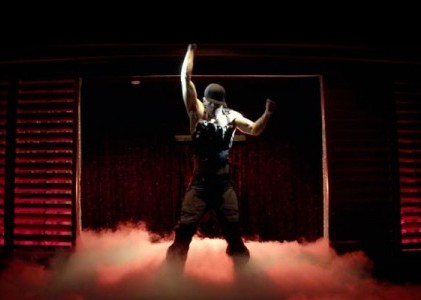Dance Dance Revolution
There are rare moments when history rears up on its hind legs and stands before you as a human figure: in this case a well-oiled gentleman, prone to bouts of dancing. Dirty dancing.
This is the vision shared, albeit in incommensurate ways, by Steven Soderbergh's Magic Mike and Scott Speer's Step Up Revolution. I am hoping that someone right now is conducting a quantitative study of dance movies per annum in relation to world economic crisis; until such empirical work is complete, qualitative analysis will have to suffice.
Magic Mike concerns strippers in an all-male review at the club Xqisite in Florida. The central triad features Dallas (Matthew McConaughey) as the former stripper who now owns the club and runs the show; Adam a.k.a. "The Kid" (Alex Pettyfer) as the ingénue; and, at the pivot of the action, Magic Mike himself (Channing Tatum, on whose youthful experiences the film is based). Mike gets a love interest, who is also Alex's sister; this is largely an exigency of the need to provide Hollywood films with a plot. It is of interest in so far as it provides an opportunity to screen more occasions of female sexual desire, particularly of the public variety. The film is interesting and ambiguous on this topic; as Hannah Tennant-Moore has noted, much of that desire is organized by fantasies of male domination, as play-acted by the troupe with the paying customers.
What this account misses is that, well, the dudes work in a service industry, while the women are customers. As customers, they are always right. The performance of gender dynamics is nested—explicitly—within the dynamics of client and service provider, which provides at a minimum a counterbalance, domination-wise. And it is against this fact as well that one of the film's striking features appears: women are by and large not punished either for sexual desire or for its public display. Perhaps this is an apology for the extraordinarily punitive fate meted out to the unfaithful wife in Soderbergh's Contagion. More likely, it is because, despite its stylized hetero-swinger proclivities, the film is interested in men.
Chiefly, it is interested in Mike. In tough-times Tampa, he dreams of opening a custom furniture shop. For the moment, he is on the hustle: working construction, building furniture, detailing cars, and a few other jobs. And then there is the dancing. As the lead ass shaker/money maker, he enjoys a privileged status at the club. Dallas, who plans to move the operation to Miami and the big time, keeps Mike on the hook with promises to make him a part-owner, garnering much-ballyhooed "equity" rather than a wage. "Points on the package," as they call it in The Wire.
There is a certain puzzlement, on this side of the screen, concerning Mike's popularity. His performances are appealing, and sexy enough. But his choreography (by Alison Faulk) is, for the world of dollar dancing, ludicrously artsy. Much of it takes place at a good distance from the paying customers, and not in a slow-tease kind of way. It is complicated, energetic, and often too fast—especially his final number, done up in police tactical gear, which unfolds behind a ground layer of dry ice smoke, set to harsh electronic music and chemical lighting. We are given to believe that this is incredibly hot. Perhaps so. It resembles no strip club in this world.
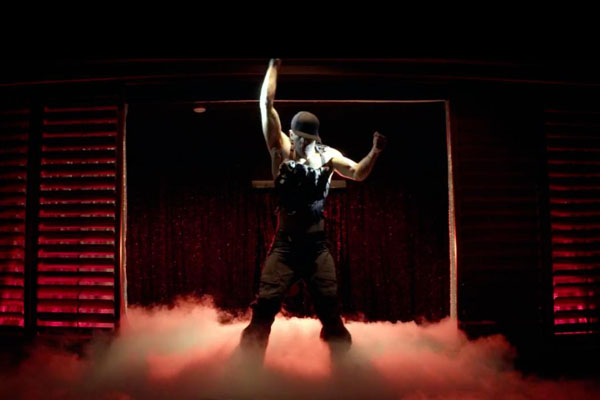
Magic Mike
Tatum has always been a pleasingly physical dancer, in part because he is more expressive in motion than in speech. At his best, he makes this barrier into a character trait, a frustration at his own inarticulacy that oscillates between good-natured humility and rising anger. This comes to a head when he goes in for a small business loan, with his folios of business plans and furniture designs. The bank officer is flustered by his allure, but in the end his record trumps his charms. A creature of informal economies, paid in cash, Mike has no credit history. He tries his hand at sweet talk, entrepreneurial patter, and pleading; it just gets worse. When she refers to special bank programs to assist "qualified distressed clients," he slips into barely managed fury: "I read the papers. The only thing that's distressed is y'all." Cut to the next month.
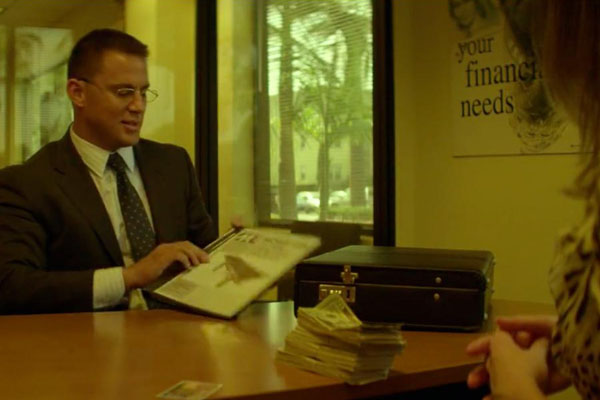
Magic Mike
Magic Mike is a film, at its core, about a sex worker during the prolonged financial crisis, starring an actor who has also been that manner of sex worker in real life. The character is not altogether miserable, but pushed into economic distress and increasing precarity. A representative of immaterial and affective labor, from a macroeconomic perspective such a worker is a true figure of the crisis: ironically both victim and cause, locked in a sort of dance of death with the declining profitability of capital. The simultaneous subject-object of the crisis, let's say, in ways that dovetail quite cruelly with the exaggerated subjectification and objectification of the sex worker.
But then, this precisely describes The Girlfriend Experience, starring Sasha Grey. Why would Steven Soderbergh make the same film twice in three years? Or, to ask the same question from a different perspective: why would he remake The Girlfriend Experience for Hollywood, this time with a male lead (and, relatedly, from a slightly less abjected profession)?
I should really break the habit of asking questions that cannot possibly be answered within our given constraints. It would be both true and obvious to say that the earlier movie was more compelling, in part because it had no need to traffic in compulsory events of the cineplex Olympics: no dull romance, no structural resolution, no final gesture wherein our hero becomes the master of his own fate. The call girl "Chelsea" is far more vulnerable and engaging than Mike—not because Sasha Grey is a more vulnerable or sympathetic actor than Channing Tatum but because there is no doubt that the great wave of financial catastrophe just cresting in her Manhattan will take her under, despite her maneuverings. Magic Mike can't quite take this seriously. And certainly this concerns both gender and job. In the sex work movie, men get happy endings.
Which is to say: they get to dress up as cops. The interval from The Girlfriend Experience to Magic Mike might be marked, as a matter of economic affect, by a shift from rising dread to exhausted despond. It has also been marked by a rising tide of political ferment and, in response, state violence. Mostly, in the main markets of Magic Mike, this has meant riot cops: vs. racialized rebellions, vs. university struggles, vs. Occupy encampments.
The film started shooting in the middle week of September 2011 and finished near the end of October; this is a suggestive span, to say the least. Principal photography was almost precisely contemporaneous with the span from the founding of Occupy Wall Street on September 17 to the dramatic, violent, and internationally reported first eviction of Occupy Oakland and ensuing night-time streetfight on October 25, riot cops and their objects of affection whirling through eerie floodlights behind a ground layer of tear gas. It certainly sets Tatum's big dance number in strange relief.
This is not to say that Magic Mike is about the Occupy movement. It is not the same kind of pop-political bait as the recent iteration of Batman, with its poster images of populist urban uprisings. In the event of it, that film's panicky bricolage seemed both to invite and resist such readings (in oft-nettlesome ways, taken on at length by Mark Fisher and Rob White in Film Quarterly). Magic Mike, after all, is just a movie about dancers in Florida, in the midst of some systemic transformation that eludes them beyond the most personal levels.
But that too precisely describes a contemporaneous film, Step Up Revolution. The proudly formulaic, deeply trivial, and inconsistently pleasing Step Up franchise has been around since 2006; if it has an organizing principle, it is the television show So You Think You Can Dance, from whose judges it draws its main producer, and from whose contestants it draws many cast members. The inaugural film launched the career of a different kind of dancer altogether: model and ex-stripper Channing Tatum.
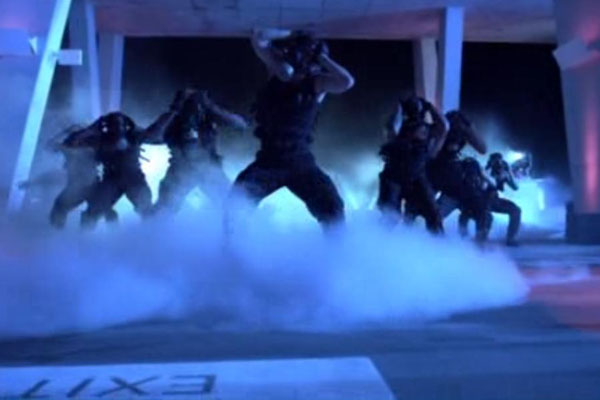
Step Up Revolution
The first three were set in Maryland (twice) and New York; the latest adventure of plucky street dancers facing institutional adversity in impossibly shiny strobed-out 3D, unfolds in Miami.
These would be arbitrary coincidences but for the plot, which bears some rehearsing. There is a shadowy dance collective, known only as "the Mob." No really. "The question on everyone's mind," insists one newscaster, "Who is the Mob?" They stage highly choreographed flash mobs in Miami, temporarily occupying public spaces—all of which they diligently capture on video toward winning a high-value YouTube popularity contest. Despite their relatively minor and even appealing diversions of civic life, they inspire implausibly operatic fury from locals, who curse and pound their dashboards and decry them as a scourge.
Shortly the Mob runs afoul of real estate tycoon Bill Anderson (Peter Gallagher), who plans to tear down the ragtag band's appropriately ethnic working class neighborhood for some world-class waterfront development. All that is solid melts into luxury hotels. Developer's daughter Emily (Kathryn McCormick), a dancer who of course has fallen in with the Mob, encourages them to make the leap: "Enough with performance art. It's time for protest art! We can change things." And so they turn their anonymous interventions against the creative destruction of the city, in hopes of diverting the course of gentrification, finance-driven restructuring, and in general the capital-intensive remaking of the city in late modernity. By dancing.
But with "Revolution" comes puzzlements. The Mob's two leaders, Sean and Eddie (Ryan Guzman, Misha Gabriel), have differing ideas about how to proceed. Sean, the romantic lead, is committed to playful, discursive interventions toward winning public sympathy. This course seems to be working: support for the redevelopment erodes. Eddie, however, believes more dramatic steps will be needed. Sean dresses in white, Eddie in black. It's not a subtle film.
The conflict comes to a head during a performance planned in Sean's absence. At rooftop festivities celebrating both the waterfront plan and alliance between tycoon, city council, and mayor, the Mob intervenes.
First they hack the celebratory video presentation. Then the real show begins. A gas canister slides across the floor, and then several, disbursing their (cosmetic, it will turn out) payloads. The designer-label denizens of the upper classes, already spooked, panic. Running, shrieking, overturning of champagne bottles. Through a ground layer of smoke, lit by hard white floods and tracked to angry electronic music, some number of anonymous dancers enter. They are anonymous because they are all dressed as Channing Tatum.
Or at least as Magic Mike. They all wear tactical vests over nude torsos, and military cargo pants, essentially indistinguishable from Mike's last dance. The only difference is the gas masks. "TIME FOR REVENGE," affirms the video screen. "MOB STYLE." The significance of the scene, such as it is, is secured when a dancer leaps athletically onto a table, shattering an elaborate centerpiece. Police arrive to break things up; more running, smoke, chaos. It's a riot.
Who is the Mob? Despite the scene's and the film's mess of signifiers, there can be little mystery: it's Occupy Oakland. It was there that protestors faced off directly and repeatedly with city council, mayor, and elite classes, albeit with a broader anti-austerity politics than the film allows. It was there that flash mob and riot achieved a certain indistinction; every instant was obsessively livestreamed and recorded; rebels and riot cops faced each other through clouds of tear gas.
Most crucially for the allegory, it was at Occupy Oakland that the debate between symbolic protest and material struggle (for which the flashpoint is inevitably "property destruction") retained an irresolvable tension. For those attentive to the events and the politics, much less anyone who lived through this, Step Up Revolution unfurls, for all its confusion, with dreamlike fidelity.
Within that, the confusion allows the film to renarrate matters to its liking: in this first climactic scene, the protestors in their confrontational mode are costumed simultaneously as riot cops and as masked-up, black-clad anarchists. This affords us some sympathy with the wealthy and the powerful whose party they crash, and with the regular uniforms who break things up. More importantly, it provides an alignment that doesn't exist in the real world: militants and paramilitary police on one side, idealized and abstracted common folk on the other. Bad protestors are bad cops and vice versa. We can simply separate out good protestors from bad, good cops from bad, and stand with the good.
This is the film's dream; the denouement thus cannot be surprising. The Mob is disqualified from the contest and thus from wealth itself by the corporate office; "they don't want to be associated with criminal activity." Moreover, the band loses its traction with the broader public; Anderson's plans will move ahead.
But the Mob doesn't quit. The final showdown will take place at the development's groundbreaking, on the water at a container dock. Bigwigs make ready with the golden shovel. But wait! Here comes the Mob, now greatly increased in size, marching in like a citizen army, slapping ersatz nightsticks threateningly in their palms. They come with their own overvoice: "For weeks you've been asking, who's the Mob. The Mob is all of us."
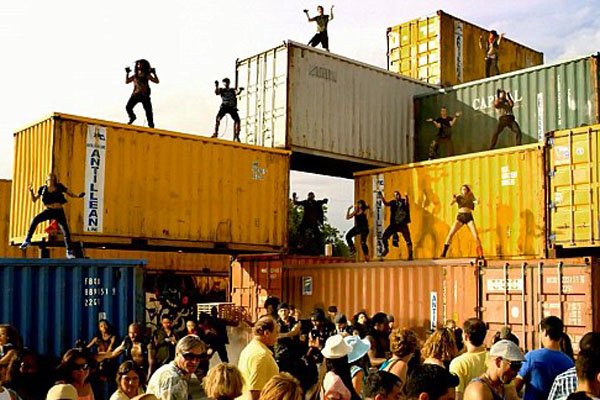
Occupy Oakland
They are many. But they are not here to fight. Having recently come down on the side of goodness, which is to say, purely expressive protest (in the symptomatically confused formulation, "what the Mob was intended to do: be heard"), they are here to shut down the port via dance. The number is prolonged, elaborate, and for the most part a delight to watch; you will not be surprised to learn that, toward the end, a line of dancers runs out bearing Plexiglass riot shields labeled THE MOB. No one will miss the reference to the constant images of riot porn from anti-austerity struggles of the last few years.
It all wins the day: the capitalist is persuaded not to build the hotel but to rebuild the neighborhood and help the underclass, the Mob is hired to represent Nike, roll credits.
Only a single mystery remains: why must this carnival of resistance, so swiftly contrived after that night of tear gas and violence, be set at a container dock? It is not the port that is to be knocked down, after all. No doubt the carefully stacked Hi-Cube intermodal containers, the basic units of global transport, make an alluring dance set. Perhaps that's all there is to it, and we should pass easily over this plot idiosyncrasy.
And yet. History presses in upon us; its claims will not be so easily dismissed. One week after the night of tear gas at Occupy Oakland, a shared outrage and a massive organizing effort led a march of 25,000 people from the city's central plaza to its vast container port, which was summarily shut down. The day featured various other activities; at one point, marchers were confronted by a local developer, guarding a building with a shotgun. As it happens, he had recently been awarded the city's largest development contract in decades—to remake the waterfront. Hollywood is an odd thing; life no less so.
It would be a matter of little difficulty to show how the film version of these dramatic events serves a certain set of ideologies, takes sides, recuperates, neutralizes. Let us assume this is so obvious that it doesn't need doing. It remains critical that it would turn out to be dance movies that wanted to take this in and make something of it—that something about dance was a way of understanding what had happened, and that what had happened might make dance itself something more.
There is an attempt here, even a necessity, to register or reach after some deep change in political directionality, from one mode of struggle to another, mediated by economic dissolution. Even if the films are compelled to insist out loud that we are just here "to be heard," the action knows something else. The films know, in the end, that we approach a conjuncture to be grasped neither via scenario nor tableau but in the kineticism of bodies in crisis, moving fast and dangerously, inevitably confrontational, antagonistic. It will be sexy and frightening but most of all it will be bodies, doing something that words alone cannot. There will be tear gas. Cop uniforms optional.
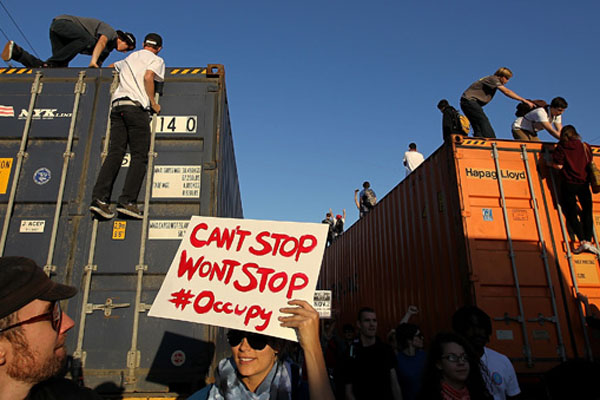
Occupy Oakland ![]()
LATEST ARTICLES
-20140814-173707-thumb3.jpg)
Fighting Words
by Imogen Sara Smith
posted August 12, 2014

Fighting Words, Part 2
by Imogen Sara Smith
posted August 20, 2014

On the Margins: The Fil…
by Andrew Chan
posted August 12, 2014

Robin Williams: A Sense…
by David Schwartz
posted August 12, 2014
 Dance Dance Revolution
Dance Dance Revolution
THE AUTHOR
Joshua Clover is the author of one film book (The Matrix, BFI 2005) and two books of poetry, the most recent of which is The Totality for Kids (University of California 2006). He has a column for Film Quarterly, "Marx and Coca-Cola"; and writes about poetry for The Nation, The New York Times, and others.
More articles by Joshua Clover
